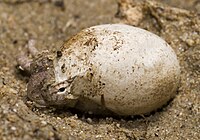Basilisk chameleon
| Basilisk chameleon | ||||||||||||
|---|---|---|---|---|---|---|---|---|---|---|---|---|

Basilisk chameleon ( Chamaeleo africanus ) |
||||||||||||
| Systematics | ||||||||||||
|
||||||||||||
| Scientific name | ||||||||||||
| Chamaeleo africanus | ||||||||||||
| Laurenti , 1768 |
The basilisk chameleon ( Chamaeleo africanus ), also known as the African chameleon , is a medium-sized species of chameleon with a helmet-like bulge on its head.
description
The color varies between green, brown and yellow tones with an alternating pattern of vertical stripes. However, the coloring is subject to a change in color depending on the mood. Stressed animals often show dark spots or in extreme cases even turn completely black. A light stripe that runs along the belly side is always recognizable. The total length can be up to 47.5 cm, but on average it is 30 to 35 cm. About 50 percent of the total length is accounted for by the tail, which serves as a climbing aid and is curled up under the belly when it is at rest. A ridge consisting of small, pointed horn scales extends across the middle of the back. Fingers and toes have grown together in pairs and act like grippers. On the forelimbs, three fused fingers point inwards and two outwards. This is exactly the opposite on the hind limbs. Basilisk chameleons have protruding, cone-shaped eyes that are surrounded by a ring-shaped lid. The pupil is in the middle and can only be seen through a small opening. As with all representatives of the genus Chamaeleo , the eyes can be moved independently in different directions. Both sexes reach a maximum age of 4 to 5 years, but usually much less (1 to 2 years). Males differ from females in that they have a comparatively higher helmet and a heel spur on their hind limbs. Pregnant females are distinguished by their yellow-turquoise striped and spotted color. Newly hatched young animals are gray, brown or cream-colored (not green).
distribution and habitat
Mali, Niger, Nigeria, Cameroon and Gabon to Egypt, Eritrea and Sudan. A population that was probably introduced in ancient times lives in a tiny area in the southwest of the Peloponnese . Basilisk chameleons colonize dense bushes and trees ( tamarisks , oaks , junipers , olive trees, but also reeds and eucalyptus ).
Reproduction
The reproductive behavior of the basilisk chameleons living in Europe has been well researched: the mating season lasts from the beginning of August to September. Once a pair has found each other, it usually stays together for several days and sometimes mates several times before separating again. The female is constantly pursued and courted at a short distance. Even during the night, the male holds the partner by the tail or limbs. The first copulations take place immediately after awakening . A female lays an average of 30 to 50 eggs in self-dug holes in September and October. Depending on their constitution, however, smaller females can only deposit 20 eggs, while large and old ones can deposit up to 90 eggs. The nests are about 30 to 40 cm below the surface of the sandy ground and are carefully pushed back in after the eggs have been laid. The entire process can take up to 20 hours and more, but with an optimal substrate (slightly damp and dry sand) it can be completed after a few hours. The incubation of the eggs lasts 11 months, so that the almost 55 mm long and 0.8 to 1.2 g heavy young animals only break free from the deep sand in the following summer. The sexual maturity is already achieved with just under 10 months.
nutrition
The diet consists mainly of insects and arachnids. In addition, the ingestion of small lizards , crabs and snails could be observed. Prey animals are grasped with the tip of the extensible tongue, which the chameleon can snap out up to its own body length. It has not yet been possible to determine with certainty whether the plant remains found in excrement examinations were accidentally or deliberately entered the digestive tract.
Danger
In Africa, the species is threatened locally by environmental changes. The only occurrence in Europe is in a Natura 2000 area. Despite the strict protection status, the approximately four kilometers long and only a few meters wide habitat is acutely endangered by a major tourist project. The use of the egg-laying areas for a beach bar in the core zone of the Natura 2000 area and the destruction of important nesting dunes on the edge of the occurrence have already visibly weakened the already small population . Sooner or later, under the current circumstances, further survival of the species will no longer be guaranteed.
Individual evidence
- ↑ a b c d Benny Trapp: Amphibians and reptiles of the Greek mainland. NTV, Münster 2007, ISBN 978-3-86659-022-9 , pp. 130-135.
- ^ Benny Trapp: Report on the collapse of the chameleon project in the Peloponnese
literature
- Benny Trapp: Amphibians and reptiles of the Greek mainland. NTV, Münster 2007, ISBN 978-3-86659-022-9 , pp. 130-135.
- Heiko Werning : Ecotourism de luxe: Is it over for the chameleon protection project in the Peloponnese? In: Reptilia. Vol. 15, No. 5 = No. 85, 2010, ISSN 1431-8997 , pp. 3-8.
- Michael Wirth: The Mediterranean - Landscapes and Herpetofauna in Southern Europe. In: Draco. Vol. 11, No. 42, 2010, ISSN 1439-8168 , pp. 4-23.


